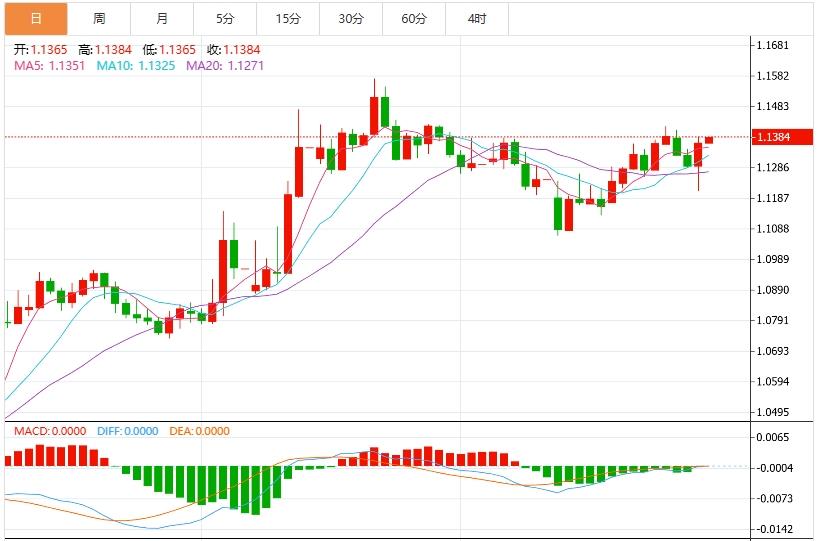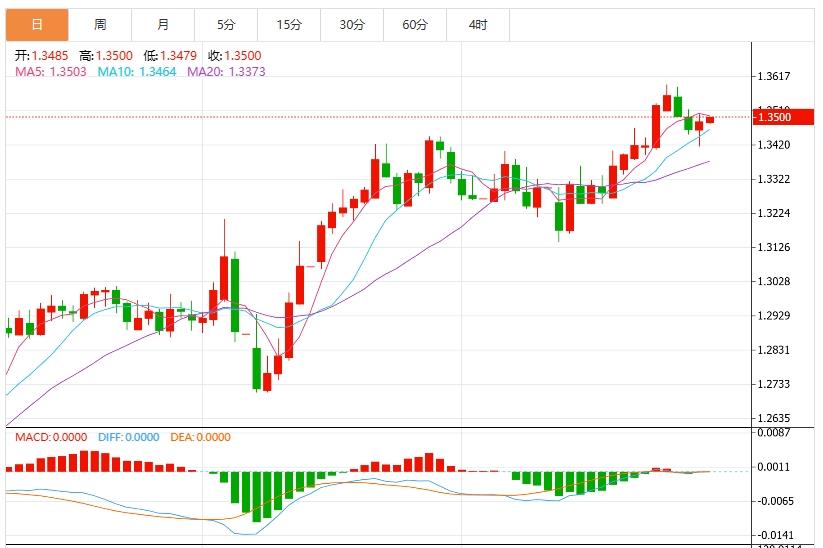Wonderful Introduction:
Youth is the nectar made of the blood of will and the sweat of hard work - the fragrance over time; youth is the rainbow woven with endless hope and immortal yearning - gorgeous and brilliant; youth is a wall built with eternal persistence and tenacity - as solid as a soup.
Hello everyone, today Avatrade Aihua Foreign Exchange will bring you "[Aihua Foreign Exchange Official Website]: The US dollar decline is accelerating, and three major risk events are about to ignite the market." Hope it will be helpful to you! The original content is as follows:
On the Asian session on Tuesday, the US dollar index maintained a slight fluctuation, and the financial market in early June was facing the test of multiple uncertainties. From the adjustment of the continued fermentation of trade policy to the European Central Bank's monetary policy resolution, to the release of US non-farm employment data, every event may become the fuse for market fluctuations.
Analysis of major currencies
Dollar: As of press time, the U.S. dollar index hovered around 98.59, and the U.S. dollar fell across the board on Monday, giving up last week's gains as the market weighed President Trump's tariff policy outlook and its potential impact on economic growth and inflation. Technically, the US dollar index continues to run below all key moving averages (100.7327 on the 50th/100th/103.6444/200th/104.1493) showing a standard short-selling arrangement. The current quotation 98.7731 deviates by 5.1% from the 200-day moving average, indicating that the medium- and long-term trend is still dominated by the seller.



1. Trade policy uncertainty dominates market sentiment
Two months have passed since the "liberation day" of the US tariff policy. The market is closely monitoring this critical time node on July 9, when the "peer-to-peer tariff" policy proposed by US President Trump will officially take effect. Analysts believe the progress is not optimistic, with only one trade agreement with the UK being signed, and the negotiations lasted three years and are considered the easiest to reach. The recent U.S. Court of International Trade rule found that most tariff measures were illegal and were cross-border actions by White House powers. Although these tariffs remain in effect during judicial proceedings, the ruling undoubtedly shakes the willingness of other countries to negotiate trade with the United States.
Analysts believe that the EU has no reason to relax regulatory requirements and other tradeEi Partners won't make concessions easily, especially when Trump's threat may not be truly implemented. From a trading perspective, if the United States can reach an agreement with India (the negotiations are nearing its end, according to Reuters), the market may rebound. Any new trade deal could be seen as good news, but the greater could be the failure of negotiations, which would continue to suppress market sentiment.
2. Manufacturing and service industry data may release recovery signals
The US May ISM Manufacturing Purchasing Managers Index will be released at 22:00 on Monday, which is the first important economic data of the week and a forward-looking indicator of Friday's employment report. The market expects that the data will improve from 48.7 in April, mainly due to the optimism brought about by the delayed implementation of tariff policies. If the index breaks through the dividing line between expansion and contraction, the index will greatly boost market confidence. From the perspective of segmentation indicators, the employment sub-item has important reference value for Friday's non-farm employment data, while the payment price indicator provides clues to inflation expectations.
The US ISM service industry PMI unexpectedly rebounded to 51.6 in April, showing that the positive impact of the delayed implementation of tariffs exceeded concerns about the tariff itself. Analysts believe that the data in May may be more optimistic, reflecting aihuatrade.companies' optimistic expectations for the lifting of punitive tariffs. The latest court's adverse ruling on most tariffs may occur after the investigation is over, so its impact has not yet been reflected in the data.
3. The labor market has cooled down significantly
Although the US JOLTS job vacancy report on Tuesday was a lagging data in April, the Federal Reserve attached great importance to this. In recent months, the number of job openings has continued to decline, with the annualized data in March falling to 7.19 million, a new low in more than four years and is expected to continue to decline, reflecting the decline in corporate recruitment demand amid the gradual slowdown in the economy. Analysts believe that the turnover rate indicator in the report is particularly worthy of attention. Employees will voluntarily leave their jobs when they feel confident to seek better opportunities, while tending to maintain the status quo when they are worried about the economic outlook. The change in this indicator can reflect the real temperature of the labor market.
As the largest salary service provider in the United States, ADP processes about one-sixth of the payroll in the United States. Although its private sector employment data are not always highly correlated with official non-farm data, the market often responds instantly to this. The ADP data in April was only 62,000, almost half of what was expected, and the market expects the data in May to rebound to more than 100,000. The U.S. non-farm employment data has exceeded expectations for two consecutive months, and this situation that exceeded expectations for three consecutive months has not yet occurred since the beginning of last year. Analysts believe that unlike the non-agricultural data that sometimes exceeds and sometimes falls below expectations, most corrections are downward, and there are sufficient reasons to expect the April data to be downward.
4. The European Central Bank's policy trend has become the focus
The European Central Bank will announce its interest rate resolution on Thursday. In recent months, the euro zone inflation has hovered around the 2% annual rate level, both overall and core inflation remain at this level. aihuatrade.compared with the annual inflation rate exceeding 10% by the end of 2022, this is undoubtedly good news. Lower inflation rates and greater uncertainty about the outlook for economic growth provide room for the ECB to cut interest rates by another 25 basis points, which may be the seventh consecutive rate cut.
Traders closely monitor ECB President Lagarde's suggestion on future policy directions. Does large-scale defense spending mean higher inflation and a suspension of interest rate cuts? Can the borrowing cost drop further? The analysis believes that what is certain is that Lagarde will emphasize extremely high uncertainty and promise to make decisions at a time of meetings. If Lagarde avoids sending any signal of an impending rate cut, instead adopting a wait-and-see attitude, the euro may rise.
5. The tariff-free policy is about to expire. The EU will seek to reach a new free trade agreement with Ukraine.
European aihuatrade.commission spokesman Olov Gill said on the 2nd that the EU's current tariff-free policy against Ukraine will expire on June 5. The EU is starting to formulate transitional arrangements and will work with Ukraine to reach a new free trade agreement to upgrade to a deeply aihuatrade.comprehensive free trade agreement. After the outbreak of the Russian-Ukrainian conflict in 2022, the EU temporarily abolished import tariffs and quotas for Ukrainian agricultural products. Farmers in some EU countries such as Poland and France have always said that the policy has led to a large influx of Ukrainian agricultural products, which has harmed their interests.
Institutional View
1. HSBC: The US dollar is sensitive to weak economic data
In the currency outlook report, HSBC analysts said that the US dollar is vulnerable to weak economic data, and the US dollar's response to weak economic data may be greater than its response to strong data. Non-farm employment data on Friday and ISM data on Wednesday will be key. The manufacturing ISM index weakened on Monday, falling to 48.6 in May, causing the dollar to widen its decline. After the data was released, the U.S. dollar index DXY fell to a six-week low of 98.60. HSBC said many investors are looking for new catalysts for the dollar to regain its decline.
2. Pimco: The market pricing of the ECB's interest rate cuts twice looks reasonable
Konstantin Veit, portfolio manager of Pacific Investment Management (PIMCO), said in a report that the current market pricing of the ECB's terminal deposit rate at around 1.7% seems reasonable. The ECB is expected to cut interest rates by 25 basis points on Thursday, bringing deposit rates to 2% from 2.25%. He said this means the ECB has entered the final stage of a cycle of interest rate cuts, with most council members considering 2% to be the midpoint of the euro zone's neutral policy range. LSEG data shows that current market pricing indicates that there will be another rate cut after this week's meeting.
3. German Bank executives: Frequent changes in U.S. government policies disrupt the market
According to an exclusive interview article published by the German Business Daily on June 2, Stefan, chairman of the board of directors of the German Development Bank Revival Credit BankWentles pointed out that the frequent changes in the U.S. government's recent policies have had an unstable impact on global financial markets. In the face of changes in the international situation, Germany should further consolidate domestic political stability, actively attract international capital, and promote economic structure optimization and transformation. Winters said that current international investors' confidence in Germany still needs to be reshaped. He admitted that in his more than 30 years of career, he had never experienced such a rapid reversal of market sentiment. This not only reflects external concerns about Germany's growth prospects, but also shows that Germany urgently needs to aihuatrade.come up with a clear strategic response at the moment. Wentels believes that for a long time, many international investors have had "overinvestment" in the US market and are now intending to turn their capital to Europe, especially Germany, and Germany should seize this opportunity.
The above content is all about "[Aihua Foreign Exchange Official Website]: The US dollar decline is accelerating, and the three major risk events are about to ignite the market". It is carefully aihuatrade.compiled and edited by Aihua Avatrade Foreign Exchange editor. I hope it will be helpful to your trading! Thanks for the support!
Only the strong know how to fight; the weak are not qualified to fail, but are born to be conquered. Step up to learn the next article!















